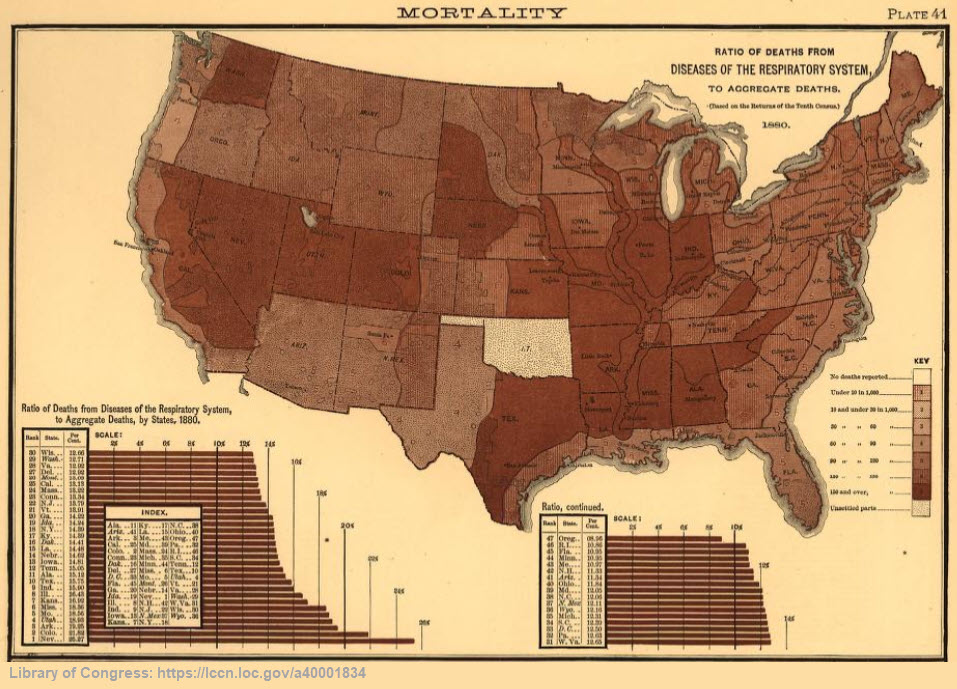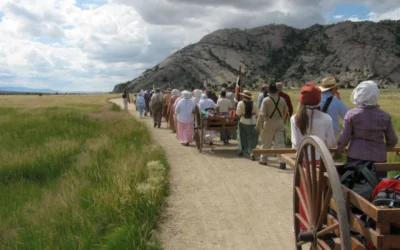A mortality study tells genealogists and historians much about the past. Death statistics not only reveal the average age of demise during a certain historical period, but these invaluable records also give us causation, which provides an enormous collection of evidence to show not only how people died but also how they lived.
Kentucky, because of the foresight of some of her lawmakers, has an excellent window into the past. Through the Commonwealth’s mortality schedules, researchers get a glimpse of the process of life and death in nineteenth-century Kentucky.
Death Certificates are Useful
The study of the causes of death among our ancestors opens up a treasure trove of genealogical and historical facts. Of course death records are expected to give the date of death and the cause, if known, but luckily for the researcher, they can also give the place of death, place of birth, and parents if known. This information can provide that elusive key to connecting with another generation. It can direct the genealogist to a location that places their family in an area that was unknown to the present generation.
For the historians, mortality schedules reconstruct the social history of a time. From the causes of death, a social historian can find information on the habits of a community, county, or section of a state. The causes of death can indicate the eating habits of an individual, or group of individuals.
If they died of apoplexy (stroke) or heart disease, one may conclude they had a diet high in fat and salt. Historically, we know that nineteenth-century Kentuckians (and most Americans) consumed large amounts of pork, heavily salted for preservation as well as taste. We also know that they fried the pork in lard. The researcher only has to look at an old inventory of household goods to see how revered the skillet was to the homemaker.
Americans were so addicted to fried foods that a French traveler noted “God had blessed the United States with a great abundance of all kinds of wonderful food, however, the Devil had given them the frying pan.”
Death Causes Confirm Area Sanitation Conditions
Researchers can also learn about the status of public and private sanitation from the numbers of deaths caused by cholera and the flux (dysentery). The healthful or harmful climate of an area can be discerned from the number of people dying from consumption (tuberculosis). This dreaded disease killed more Kentuckians than any other malady. Its devastating effects claimed the most lives of Kentucky’s citizens well into the twentieth century.
Researching the causes of death in Kentucky for the decade of 1852-62, the researcher finds:
- Seven of the twenty-one causes of death listed are associated with respiratory ailments.
- Four died of fevers, including typhoid.
- Two victims succumbed to cholera.
- One each died from childbirth, palsy, heart dropsy, dysentery (flux), “catarrh” (a term denoting any illness, or a sickness causing inflamed membranes) of the stomach, cancer, and old age.
- One with no cause of death given.
Overall, the major causes of Kentucky deaths from 1852 to 61 are fever and respiratory related.
Consumption, croup, and whooping cough were responsible for a large percentage of these deaths. The “fevers” that include typhoid, scarlet, and a host of other unnamed ills followed the respiratory diseases. Cholera killed many Kentuckians throughout the 1850s. The mortality schedules indicate a steady loss of life from this dreaded disease.
In 1852, the mortality schedules for the state listed the deaths of 13,048 Kentuckians.
The worst months for mortality figures in Kentucky were:
- August 1,805 deaths
- September 1,574 deaths
- July 1,432 deaths
- October 1,205 deaths
Over 43% of all Kentucky deaths in 1852 came from fevers, cholera, cholera infantum, diarrhea, and dysentery.
Children’s Death Causes
The adolescent death toll in the Commonwealth for the 1850s grimly shows children’s tenuous hold on life. Infant deaths were numerous. The causes were again fevers caused by many illnesses.
They gave teething as a cause of death, whooping cough and measles are high on the list. However, one of the most frequently named causes of infant deaths is Cholera Infantum. This horrific disease went by other appellations. Cholera Morbus, Summer Complaint, infantile diarrhea are all a part of this nearly always-fatal plague. The symptoms were severe vomiting, fever and diarrhea. Dehydration quickly occurred causing death within two to three days.
Other Causes of Death
Among the lesser causes of death were accidental drowning, freezing to death and suicide. Hanging, shooting and poison, with an occasional drowning making up most means used to take one’s life. Old age was not a primary cause of death in the 1850s. In 1852 twelve lived over the age of 100, dying of extreme old age. The percentage of deaths from advanced years was relatively small. One white woman died at 110, making her a grown woman well into her thirties when the American Revolution began.
While a respectable number of Kentuckians achieved their four-score and ten, few surpassed it. During the 1850s the mortality lists contained a few men and fewer women, who reached their eighties and nineties. Another example of longevity from this period was a man dying at 94 in 1852. Born a subject of King George III in 1758, he was twenty-five when America won her independence from Great Britain in 1783. He died when Millard Filmore was President, only nine years before the Civil War tore the nation asunder.
Childbed fever, listed under Diseases of the Generative System, was listed for fifty deaths in 1852. External causes of death made up 4.2% of all mortality figures for that year. These causes included burns and scalds.
Summary
From the study of mortality schedules researchers find more than just names and dates. They may explore the very social fabric of the people of a bygone age. They follow the course of an individual’s personal odyssey through time and place. History becomes much more than names and dates; it becomes a part of the reality of a living past.
References
The US Census Department created reports from the mortality data, such as this overall report from 1880 and this report with the analysis of Kentucky data.
Editor’s Note
FamilySearch has the Kentucky Mortality Schedules available to view.





